
Wound Dressings in the Golden Age of Piracy, Page 4
Pledgets (Dossils or Plumaceolus)
Pledgets were the unheralded worker dressings of the period. As Pierre Dionis explained "after an Operation, [when] a Wound requires a Tent or Pipe, one of
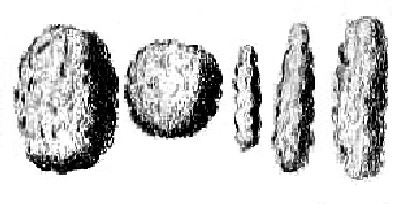
A Variety of Pledgets, from A General System of
Surgery by Lorenz Heister,
Plate 2, p. 20 (1750)
them just now describ'd is put into it; but in Wounds where there is no occasion for them, small pledgets which are Stopples of Lint, are made use of to fill the Cavity, and pledgets to cover it."1
Like tents, a pledget was called by various names in the period surgical texts including stopple, dossil and plumaceolus. Dionis explains that this last term come from the 'ancients' who used "Feathers [plumaceous - the part of the feather vane near its base] sowed betwixt two pieces of Linen, which not only imbib’d [absorbed] the Matter [in the wound], but were very proper to defend the Part from Cold, which is always an Enemy to Wounds and Ulcers, by reason that shrinking up the Fibres, which are very tender, it breaks their Order, and obstructs their Motion, by which they tend to restore themselves to their pristine State."2
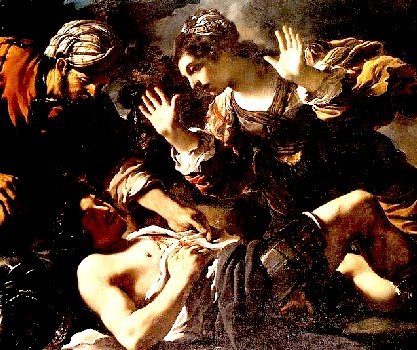
Dressing the Wounded, Ermina Finds the Wounded Tancred, by Guercino (1618)
Dionis describes four different uses for pledgets. The first was to stem the flow of blood out of a wound, "for which reason at the first Deligation [bandaging], we commonly put nothing into the Wound but Lint"3.
The next purpose for a pledget was similar to that of the tent - so that "a Wound is kept dilated, when any exotic Body or Splinter of Bone is to be drawn out [after dressing it]."4
The third use was to keep medicine in a wound and "draw out all the virulent Matter and sharp Serosities [fluid discharges] which run in the Wound.
Lastly, they guard the Wound from the Impressions of a cold Air, or such an one as is charg’d with noxious Qualities; which last Use is peculiar to the flat pledgets which cover the Wound."5
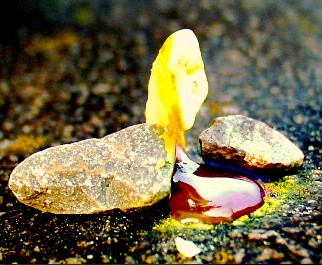
Photographer: Johannes Hemmerlein
Burnt sulfur emits a blood red liquid
Since the time of Hippocrates (and likely long before that), air coming in contact with the internals of the body was believed to be a cause of ill health. Places were thought to have good air (often high, breezy places) or bad air (often low, swampy ones) based on the prevalence of sickness among the people who lived in these types of climates.
Dionis also mentions a fifth use for pledgets - as a caustic agent. "A sort of Lint is prepar’d, which, like the Cilician Matches or Wicks, corrodes and consumes the proud Flesh which grows over Wounds and Ulcers. To which purpose several bits of Cloth are wash’d and scented with Sulphur, Nitre [Potassium Nitrate], and other such like Ingredients; after which they are reduc’d into Lint. "6 In this case, the pledget essentially served as what was called a 'potential' (or chemical) cautery, used to eliminate unwanted scar tissue.
1 Pierre Dionis, A course of chirurgical operations: demonstrated in the royal garden at Paris. 2nd ed., p. 22; 2 Dionis, p. 22-3; 3,4,5,6 Dionis, p. 23
Pledgets: Composition
Pledgets during the golden age of piracy were usually made from lint, although Dionis notes that "in the first Ages a sort of Mushrooms were made use of to dress Wounds; and in after Times, Wicks and Tow; and in other Ages, Spunges"1.
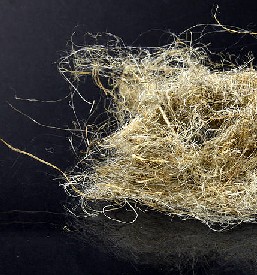
Photographer: Elke Wetzig
Flax fibers, which make up linen. This is
clearly not going to make 'handsome pledgets.
He goes on to explain that "since Linen is grown more common, the use of these other Substances is left off, and we use only Lint, which is undoubtedly preferable to all the Inventions of the Ancients for these Purposes."2 Despite Dionis' dismissal of tow in the making of pledgets, several period authors still recommend using it.3
Charles Gabriel Le Clerc tells us that lint "is made of old Rags, and yet they must not be too much worn neither; because the Threads breaking and being too short, the Pledgits are harder to make, and do not hold so well together... as large or larger than the Palm of the Hand"4. Dionis give further detail on the material to be used, explaining that it "ought not to be too course, nor too fine; neither new, nor too much worn: The first makes a harsh Lint which hurts the Wound; too much Time is spent in pulling the second; and the third besides the fineness of the Thread’s rendring it apt to conglutinate [stick together], those of new Linen continue too strong and harsh; and the fourth yields a dusty downy Lint. The middling sort is to be chosen, and above all that which is clean and well-wash’d."5
As Dionis hints in the previous statement, when creating lint, pieces of linen are pulled apart - thread by thread - and then carefully lined up. He says that "you must range by the side of one another, and not entangle them; for when they are mixed
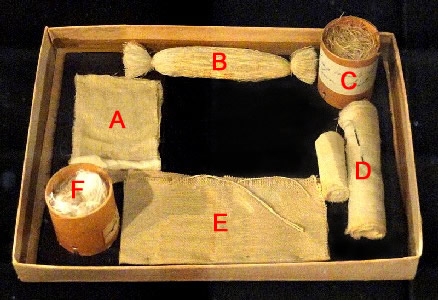
Photographer: Diderot
Civil War Era Bandages (which are nearly identical to 17th century), exhibited in the
Framingham History Center in Framingham, Massachusetts. From the placard:
A -
Piece of Linen, Ready to be Scraped; B - Drawn Lint; C - Fragments of Drawn
Lint;
D - Bandages;
E - Square of Cloth, Ready to be Drawn; F - Scraped Lint
together, it is hard to make handsom Pledgits."6
Curiously, Le Clerc suggests the opposite. In his procedure, you take the handful of thread and "comb or draw it in [your] Hand, clapping your Thumb on it to keep it whilst you are drawing it. Observe that the Threads must by no means be placed all parallel, that is, on by the sides of the other, but must cross from time to time to keep the Pledgit the better together."7 Whichever method you used, the next step was to "apply it on the Back of the Hand, and with the Flat of the other Hand rub it till it be firm and close."8
As you can see, making 'handsome pledgets' sounds like an awful lot of work. This may be why this painstaking task was left to the surgeon's assistants; James Yonge lists it as being a part of his 'slavery' that began with being indentured to a surgeon.9
Dionis does mention another way of making lint. "We also make use of Lint which is scraped off the Linen with a Knife"10. You can immediately see how much easier this would be to create. However, he suggests that this type of lint is very fine, and "its principal Use is to dry up a Wound, in order to dispose it to cicatrize [heal]."11
1 Pierre Dionis, A course of chirurgical operations: demonstrated in the royal garden at Paris. 2nd ed., p. 23; 2 Ibid; 3 See for example John Atkins, The Navy Surgeon, p. 123-4, John Woodall, the surgions mate, p. 172 and John Moyle, The Sea Chirurgeon, p. 59; 4 Charles Gabriel Le Clerc, A Description of Bandages and Dressings, p. 9; 5,6 Dionis, p. 23; 7 Le Clerc, p. 9; 8 Ibid, p. 9-10; 9 James Yonge, The Journal of James Yonge [1647-1721] Plymouth Surgeon, p. 41-2; 10,11 Dionis, p. 23
Pledgets: Their Form
Like he did for medicinal plasters and tents, Pierre Dionis gives encyclopedic detail on various kinds of pledgets. He explains that pledgets are to be "shaped proportionably to the Wound, in order to apply them dry, cover'd with Unguent, or dip'd in some Liquid, pursuant to the Intentions for which they are used."1 From there he launches into a detailed explanation of a chart of pledgets he has included in his surgical textbook.
"The three first small pledgets, marked A, B, C, which you see, and one of which is lesser than the rest, the other middle-siz'd, and the third larger, are made of pull'd Lint, and shap'd like Olives. When they are intended to dilate a Wound, they are made harder; but when they are only design'd for the Conveyance of Medicines they are made soft, that the Part may not be rashly expos'd to fretting and contusion. In case the Wound is not large, the least sort is used; and when it is large and deep, the biggest are apply'd: but 'tis always better to fill it with a greater Number of the least because they fit better.
The two others, D, E, are of the same Shape with the former, but thicker; they are tied about the middle by a Thread four or five inches long, and are
the Stopples which are first of all thrust to the bottom of a Wound, or large Imposthume; we usually tie nor
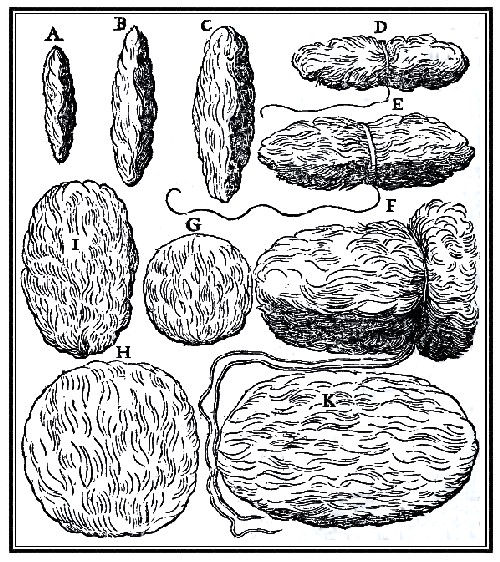
Of Plumaceoli or Plegets, A course of chirurgical operations,
by Pierre Dionis,
Table 4, p. 22 (1733)
more than the two or three first, it being unnecessary to bind the rest, because that being put in the last, they always come out as soon as we begin to draw out the Precedent [pledgets] which they cover: Thus the Thread serves to draw out the pledgets, and discover whether there be any more in the Wound, since those, to which its other end is fastned, are the last which are drawn out.
The great Stopple, F, is surrounded with a double Thread towards the head, because being fixed exactly to the size of the Wound, it frequently happens that it swells very much, and that the Wound presses it to close, that it requires a strong Thread to draw it out: 'Tis principally us'd after the Operation of Bubonocele [an inguinal or femoral hernia forming a swelling in the groin], to stop the Aperture made in the Rings of the Muscles of the Abdomen, in order to return the Epiploon [a fold of the serous membrane lining the abdominal cavity], or the Intestines.
These two pledgets, G, H, are round; the one little, and the other larger, according to the Places to which they are to be applied; they are not very thick, but they require Use and Dexterity to make them well.
The two last, I, K, are large oval pledgets, which are frequently us'd, and several are plac'd next one another when the Wound is verily large; and when a Chirurgeon makes ready his Apparatus, he ought to prepare a much larger number than he seems to want, because frequently he is obliged to cram in several, one after another, and especially when he is to stop an obstinate Hæmorrhage, which requires a considerable Compression of the Arteries and Veins whence the Blood proceeds; which is commonly done most easily by these Means, which fasten the Ligatures which are thought proper to be made about the Vessels, and retain the styptic Powders and Waters longer apply'd to the Apertures."2
Charles Gabriel Le Clerc provides an explanation for the creation of a dossil which, as he explains it,
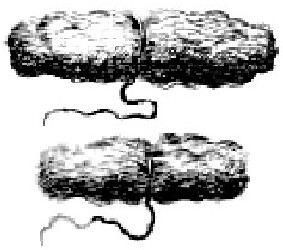
Dossils of Lint, from A General System of
Surgery
by Lorenz Heister,
Plate 2, p. 20 (1750)
is a larger version of a typical pledget. Dossils are mentioned by several surgical authors, so it is instructive to include them here, although it goes a bit more into the making of this dressing than Dionis does.
"To make a Dossil, take the Lint in your Right Hand, and draw it between your Thumb and the Fore-Finger of your Left Hand in Proportion to the Bigness you would have the Pledgit of; bend this small Packet in the midst, and raise the Ends, and roll this Dossil very strongly between both Hands to make it firm. It is a Rule that you must always tye the Dossils in the middle with a Thread, when you put them into Wounds where you think it will be difficult to draw them out, or apprehend that you may forget and leave them in, as it happens in deep Sinus [an opening in the skin that emits pus]; for the Flesh to grow over them, and the Wound cicatrize; but it would break out again, and the Relapse would be worse than the first Grievance."3
1 Pierre Dionis, A course of chirurgical operations: demonstrated in the royal garden at Paris. 2nd ed., p. 23; 2 Dionis, p. 24; 3 Charles Gabriel Le Clerc, A Description of Bandages and Dressings, p. 10

